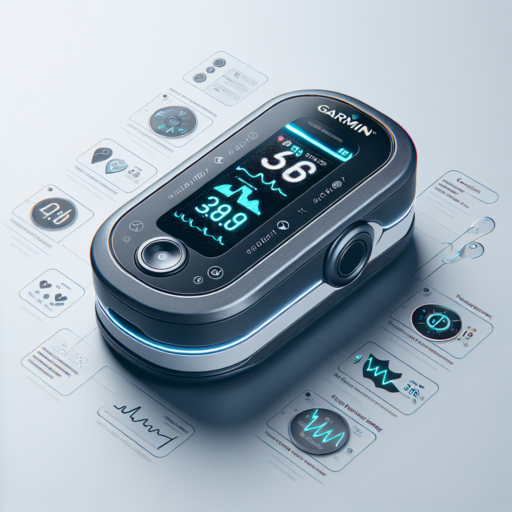Introduction to Garmin Pulse Ox Feature
Exploring the innovative landscape of wearables, Garmin has made significant strides in health and wellness technology. Among its notable achievements is the introduction of the Pulse Ox feature, a pioneering tool designed to enhance user understanding of their physical condition through precise oxygen saturation level monitoring. This feature, available in select Garmin devices, marks a leap forward in personal health tracking.
The Garmin Pulse Ox feature is engineered for individuals engaged in high-intensity workouts, altitude training, or those simply keen on monitoring their health metrics more closely. By utilizing light beams at your wrist to gauge the absorption of red and infrared light by your blood, this technology calculates your blood oxygen saturation (SpO2). The data gleaned offers critical insights into your body’s ability to absorb oxygen, a vital parameter for assessing overall wellness and physical performance.
Why Monitor Blood Oxygen Levels?
Understanding the importance of oxygen saturation levels is crucial for athletes, hikers, and fitness enthusiasts alike. Optimal levels can signify good health and efficient oxygen circulation, which are paramount during strenuous physical activities or at high altitudes. Conversely, low SpO2 levels might indicate potential health concerns that could necessitate further investigation. The Garmin Pulse Ox feature empowers users with real-time data, fostering a proactive approach to health management and performance optimization.
The Science Behind Garmin Pulse Ox Technology
The Garmin Pulse Ox technology is a pivotal advancement in wearable health monitoring, offering users a window into their oxygen saturation levels—a critical biomarker for overall health and wellness. This innovative feature leverages the principles of photoplethysmography, a non-invasive method that utilizes light beams to gauge the blood oxygen levels. At the heart of its functionality, the Garmin device emits light waves through the skin, which are then partially absorbed by the blood. By analyzing the light that is reflected back, the device can accurately estimate the percentage of oxygenated hemoglobin.
Key Components of Pulse Oximetry
The efficacy of the Garmin Pulse Ox technology hinges on several core components. Primarily, the LED sensors that emit light at two different wavelengths—red and infrared. This is pivotal because oxyhemoglobin and deoxyhemoglobin (oxygen-rich and oxygen-poor hemoglobin, respectively) absorb light differently. The sensor’s capability to detect changes in light absorption allows it to deduce the blood’s oxygen saturation (SpO2) levels. Additionally, advanced algorithms play a critical role in filtering out noise and motion artifacts, ensuring the readings are as accurate as possible.
Understanding the Significance of SpO2 Readings
Oxygen saturation levels, or SpO2, provide vital insights into an individual’s health, particularly concerning respiratory and cardiovascular system efficiencies. By monitoring these levels, users can get early warnings about potential health issues that might require medical attention. However, it is important to understand that while Garmin’s Pulse Ox technology offers a convenient way to track SpO2, it should not be used as a substitute for professional medical advice. The technology is designed to enhance wellness tracking and enable users to make more informed health decisions.
How Accurate is Garmin Pulse Ox Compared to Medical Devices?
When assessing the accuracy of Garmin Pulse Ox technology compared to traditional medical devices, there are several key factors to consider. Garmin devices that feature Pulse Ox use a method known as pulse oximetry to estimate the saturation of oxygen in the user’s bloodstream. While this technology offers convenience and the ability to track changes over time, it’s essential to understand how it compares in precision to the devices used in healthcare settings.
Understanding the Technology Behind Garmin Pulse Ox
Garmin’s Pulse Ox sensors work by shining lights at the skin and measuring the amount of light absorption, which correlates to blood oxygen levels. Although this method is widely accepted for non-medical tracking of oxygen saturation levels, variations in skin thickness, pigmentation, and even the current level of activity may influence the readings. Professional medical devices are typically more sophisticated, designed for clinical accuracy and often involve calibration to the individual patient needs, which can lead to a perceptual gap in precision between the two.
Comparative Studies and User Experiences
Several comparative studies have sought to understand how Garmin Pulse Ox stands up against the gold standard of medical-grade oximeters. These studies typically examine the consistency of readings under various conditions, such as at rest or during physical activity. While Garmin devices provide a good indication of overall trends and are invaluable for non-clinical purposes like altitude acclimatization or tracking sleep quality, they are generally not recommended for medical diagnostics. It is important to note, however, that user experiences often highlight the practicality and ease of use of Garmin Pulse Ox for everyday monitoring, showcasing its value beyond mere clinical measurement.
Through this analysis, it becomes evident that while Garmin Pulse Ox sensors offer a convenient and accessible way to estimate blood oxygen levels for general wellness and fitness tracking, they may not always match the accuracy levels of specialized medical devices. This distinction is crucial for users to understand, ensuring that Garmin’s technology is leveraged for its strengths in lifestyle tracking rather than as a substitute for medical evaluation.
User Experiences: Garmin Pulse Ox Accuracy in Real Life
In the world of wearable technology, the Garmin brand stands out for its commitment to health and fitness monitoring. One of the advanced features offered by certain Garmin models is the Pulse Oximeter function, designed to measure blood oxygen saturation (SpO2) levels. The accuracy of Garmin’s Pulse Ox sensors in real time has been a topic of much discussion among users and enthusiasts. This feature is particularly available in Garmin’s fitness and outdoor watches, aiming to provide athletes and adventurers with vital data about their physical condition, especially at high altitudes where oxygen levels might be significantly lower.
The personal experiences of Garmin users indicate a range of reactions to the Pulse Ox accuracy. Many users have found the measurements to be in close agreement with medical-grade equipment, especially in steady-state conditions such as sleep monitoring. For instance, individuals who track their sleep with Garmin devices equipped with Pulse Ox sensors report insights into their breathing irregularities and possible sleep disturbances like apnea, which in some cases, have encouraged medical consultation and diagnosis. This insight underscores the potential of Garmin’s Pulse Ox feature not just as a fitness tool but also as a preliminary health monitor.
However, it’s essential to highlight that factors such as device placement and skin pigmentation can affect the Pulse Ox readings. Users have observed that for the sensor to provide the most accurate data, the Garmin device needs to be worn snugly above the wrist bone. Moreover, activities involving significant movements or cold environments may also impact the sensor’s accuracy. Feedback from the community suggests that while Garmin’s Pulse Ox feature offers valuable health insights and aids in performance monitoring, it should be complemented with traditional methods of measurement for critical health decisions.
Tips for Getting the Most Accurate Readings from Your Garmin Pulse Ox
Ensuring that your Garmin Pulse Ox provides the most accurate readings possible is crucial for tracking and understanding your oxygen saturation levels effectively. By following a few simple guidelines, you can improve the reliability of your device and ensure that it serves as a helpful tool in monitoring your health and fitness progress.
Ensure Proper Fit and Position
One of the most essential aspects to consider for accurate readings is how the device is worn. The Garmin Pulse Ox sensor should sit snugly on your finger, neither too tight to obstruct blood flow nor too loose to allow ambient light interference. Positioning the sensor on your index or middle finger, and ensuring that it’s flat against the skin, can significantly impact the accuracy of the readings.
Maintain a Steady Arm
Motion can greatly affect the precision of pulse oximetry. For the best results, keep your arm still and avoid moving during measurement. Resting your hand on a flat surface or holding it against your body can minimize shakes and provide a stable environment for the Garmin Pulse Ox to perform its analysis. Remember, the goal is to replicate a restful state, where readings are typically most reliable.
Avoid External Light Interference
External light can interfere with the sensor’s ability to measure your oxygen saturation accurately. When taking a reading, make sure to cover the device and your finger completely, avoiding exposure to direct sunlight or strong indoor lighting. Utilizing a cloth or simply ensuring your hand is fully enclosed (such as in a pocket) can help block out extraneous light and improve the precision of the data captured by your Garmin Pulse Ox.
Comparing Garmin Pulse Ox with Other Brands
When discussing the landscape of wearable technology, especially devices equipped with health monitoring capabilities, it’s imperative to consider how the Garmin Pulse Ox sensor stacks up against its competitors. Garmin, known for its robust and accurate fitness trackers and smartwatches, integrates the Pulse Ox feature across many of its models. This feature measures blood oxygen saturation levels, offering users vital health information.
Accuracy and Reliability
One pivotal aspect when comparing Garmin’s Pulse Ox feature with other brands is the accuracy and reliability of the readings. Garmin employs advanced sensors and algorithms, ensuring that the data presented to the user is both reliable and precise. This is essential for athletes and fitness enthusiasts who rely on these metrics to optimize their training and recovery. Other brands, while offering similar functionality, often differ in their approach to data accuracy, with some users noting variability in the readings.
Integration with Other Health Metrics
Garmin’s ecosystem offers a comprehensive overview of an individual’s health by integrating the Pulse Ox readings with other vital metrics such as heart rate, sleep quality, and stress levels. This holistic approach provides a more detailed and actionable insight into one’s overall wellbeing. Comparatively, other brands may offer Pulse Ox sensors as well; however, the integration and interpretation of this data within the wider context of health monitoring can vary, affecting the user’s ability to make informed decisions based on their device’s feedback.
In terms of user experience, Garmin devices that feature the Pulse Ox sensor tend to emphasize not only the functionality but also the ease of access to this information. Through Garmin Connect, users can easily track trends and make adjustments to their lifestyle or training regimen. This contrasts with some competitors who may not offer as intuitive a platform for data analysis and historical trend monitoring.
Factors That Can Affect Garmin Pulse Ox Accuracy
Understanding the accuracy of your Garmin Pulse Ox sensor is crucial for those who monitor their health metrics closely. While these devices are designed to provide reliable data, there are several factors that can impact their precision. Recognizing these elements can help users in ensuring they get the most accurate readings possible.
Skin Perfusion
Skin perfusion, or the blood flow to the skin, is one of the primary factors that can influence the accuracy of Pulse Ox readings. Cold temperatures or physical conditions that reduce blood flow can lead to less accurate measurements. Ensuring your body is warm or at a normal temperature before taking a reading can mitigate this issue.
External Light Interference
Another crucial factor is external light interference. The Pulse Ox sensor uses light to gauge oxygen saturation; thus, exposure to direct sunlight or other strong lighting conditions can skew the results. It is advisable to cover the device with your sleeve or take readings in well-controlled lighting conditions to ensure the most accurate data.
Wearer Movement
Movement during measurement can also significantly affect the accuracy of Garmin Pulse Ox readings. When the sensor moves relative to the skin, it can disrupt the signal, leading to potential inaccuracies. For the best results, remain as still as possible during the measurement process.
Frequently Asked Questions About Garmin Pulse Ox Accuracy
Understanding the accuracy of Garmin’s Pulse Ox feature is essential for users who rely on this tool to monitor their blood oxygen levels, particularly during sports and high-altitude activities. Garmin’s Pulse Ox sensors use light beams at various wavelengths to gauge your blood’s oxygen saturation. This method, while highly innovative, has raised questions regarding its precision and reliability in everyday use.
How Accurate Is the Garmin Pulse Ox? The Garmin Pulse Ox aims to deliver close estimates of your blood oxygen levels, yet, as with any wrist-based sensors, various factors such as skin perfusion, physical condition, and device fit can affect its accuracy. Garmin’s technology is designed for general wellness and fitness purposes, providing valuable insights for users rather than medical-grade data.
Can Environmental Factors Influence Garmin Pulse Ox Readings? Yes, environmental factors play a pivotal role in the performance of the Pulse Ox sensor. Conditions such as cold weather can reduce blood flow to the skin, potentially affecting the sensor’s ability to accurately measure oxygen saturation levels. Similarly, movements or poor fit of the device can lead to discrepancies in readings, underscoring the importance of properly wearing the Garmin device during use.
Understanding the Benefits of Monitoring Your Blood Oxygen with Garmin
Monitoring your blood oxygen levels, also known as SpO2, has become a key aspect of health optimization. Garmin devices offer an innovative way to keep an eye on this vital health metric, directly from your wrist. Understanding how this feature works and the benefits it brings can help you make more informed decisions about your health and fitness regime.
Enhanced Awareness of Your Physical Well-being
By consistently monitoring your blood oxygen levels with a Garmin device, you gain immediate insights into your physical health. This continuous monitoring can alert you to potential health issues before they escalate, serving as a preventative measure. It’s particularly beneficial for individuals engaged in high-altitude activities or those with specific medical conditions, providing a layer of safety and reassurance.
Optimization of Fitness and Recovery Strategies
Understanding your SpO2 values can significantly impact your fitness routines and recovery periods. Garmin’s sophisticated algorithms analyze your blood oxygen data to suggest personalized adjustments in your fitness plan. This means your workouts can be tailor-made to optimize oxygen usage, enhancing endurance and overall performance. Additionally, recognizing the proper times for rest and recovery, based on your SpO2 levels, ensures you’re giving your body exactly what it needs to rebuild and strengthen.
Conclusion: The Verdict on Garmin Pulse Ox Accuracy
When it comes to evaluating the accuracy of Garmin’s Pulse Ox technology, there are several facets to consider. Garmin devices equipped with this functionality aim to provide users with insights into their blood oxygen saturation levels, an increasingly popular metric for athletes and health-conscious individuals alike. However, the crucial question remains: how reliable are these readings?
First and foremost, it is important to acknowledge that Garmin’s Pulse Ox sensors use light beams to estimate blood oxygen levels. This methodology, known as pulse oximetry, is common in wearable technology but can be influenced by various factors including skin pigmentation, physical activity, and the device’s fit on your body. Although Garmin continually works to enhance the accuracy of their devices through software updates and algorithm improvements, users may still experience some variations in readings.
Despite these challenges, numerous users and independent studies have noted a high level of precision in Garmin Pulse Ox readings. Comparisons with medical-grade devices suggest that while Garmin’s technology might not replace clinical tools, it offers a reliable estimate for non-medical purposes. As with any health tracking technology, it’s advisable to use Garmin’s Pulse Ox feature as part of a broader approach to wellness, considering both its potential and its limitations.










